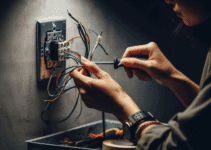Maintaining a level yard is crucial for several reasons, each contributing to the overall functionality and enjoyment of the outdoor space. One of the primary benefits is improved aesthetics. A smooth, even lawn provides a visually pleasing landscape, enhancing the curb appeal of your property. This balanced terrain creates a harmonious environment that can elevate the overall look of your home.

Please, read our post and do not forget to check our YouTube channel “Grig Stamate”:
https://www.youtube.com/@GrigStamate
You will find there, thousands of designing, furnishing, and decorating ideas for your home interior and outdoors.
Allow me to mention one of them:
Charming Décor Ideas for Home Interiors and Outdoors (video)
In addition to aesthetics, a level yard plays a significant role in promoting better drainage. Uneven surfaces often lead to water pooling, which can cause potential flooding and damage to both plants and property. Proper drainage ensures that water is evenly distributed across the yard, preventing the formation of puddles and reducing the risk of soil erosion. This not only protects the integrity of your landscape but also minimizes the likelihood of mosquito breeding grounds that thrive in stagnant water.
Easier mowing is another advantage of maintaining a level yard. Lawnmowers operate more efficiently on flat terrain, resulting in a more uniform cut and reducing the wear and tear on your equipment. Uneven ground can cause the mower to scalp the lawn in some areas while leaving others too long, leading to an unsightly appearance and potential damage to the grass.
Enhanced safety is a critical consideration, particularly for households with children or elderly family members. A yard riddled with bumps and divots poses tripping hazards, increasing the risk of injury. A smooth surface provides a safer environment for outdoor activities, allowing everyone to enjoy the space without concern for potential accidents.
Finally, a level yard makes gardening and other activities more enjoyable. Planting, weeding, and other garden tasks are more manageable on even ground, allowing you to focus on the joy of gardening rather than struggling with uneven terrain. Whether you’re hosting a backyard barbecue or playing a game of catch, a smooth yard ensures a more pleasant and functional outdoor experience.
Tools and Materials Needed for Levelling Your Yard
Successfully leveling your yard demands the right tools and materials to ensure thorough and efficient work. Essential items include a shovel, rake, wheelbarrow, topsoil, sand, lawn roller, and potentially a string level or laser level. Each of these tools and materials plays a specific role in the yard leveling process, making it crucial to understand their purposes and where to source them.
A shovel is indispensable for digging out bumps and filling in divots. Choose a sturdy, well-crafted shovel that can handle heavy use. Hardware stores and garden centers typically have a good selection.
The rake is used to spread the topsoil or sand evenly across the yard. A landscaping rake with strong tines will be most effective for this purpose. These rakes can also be found at garden supply stores or online retailers.
A wheelbarrow is essential for transporting heavy loads of soil, sand, or debris across the yard. Look for a wheelbarrow with a durable construction and pneumatic tires for easy maneuverability. Wheelbarrows are widely available at home improvement stores and garden centers.
Topsoil and sand are the primary materials used to fill in low spots and smooth out the yard surface. Topsoil is generally used for larger areas, while sand can help with finer adjustments. These materials can be purchased in bulk from landscape supply companies or in bags from garden centers.
A lawn roller is crucial for compacting the soil after leveling. This ensures a smooth, even surface. Lawn rollers can be rented from equipment rental shops or purchased from garden supply stores.
Finally, a string level or laser level helps ensure the yard is leveled accurately. These tools provide a visual guide to maintain a consistent level across the yard. String levels are inexpensive and found in most hardware stores, while laser levels can be more costly but offer greater precision and ease of use.
Gathering these tools and materials beforehand will equip you to tackle the yard leveling project effectively, ensuring a smooth, even landscape that enhances the appearance and usability of your outdoor space.
Step-by-Step Guide to Removing Bumps and Divots
Leveling your yard is essential for ensuring a smooth and even surface, which can help prevent injuries and improve the overall appearance of your lawn. To start, you need to mark the uneven areas. Use stakes and string to outline the bumps and divots, making it easier to identify where you need to focus your efforts. Once you have marked these areas, remove any debris, such as rocks, sticks, or old roots, to create a clean working space.
Next, dig out the bumps using a shovel or spade. Carefully remove the excess soil from the raised areas, making sure to keep the ground as level as possible. It’s important to dig slightly deeper than the surrounding ground to allow for proper compaction later. As you dig, be mindful not to remove too much soil, as this can create new divots and exacerbate the problem.
After addressing the bumps, turn your attention to the divots. Fill these low spots with a mixture of topsoil or sand. Use a rake to distribute the material evenly, ensuring that it blends well with the surrounding soil. It’s crucial to maintain a proper soil consistency; too much sand can cause drainage issues, while too much topsoil can lead to compaction problems. Aim for an even mix to promote healthy grass growth.
Once you have filled in the divots, it’s time to compact the soil. Use a lawn roller or a tamper to press the soil down firmly. This step is essential for preventing future settling and ensuring that the ground remains level. Make several passes over the area, applying consistent pressure to achieve the desired compaction. If you don’t have a lawn roller, a heavy piece of plywood can also be used to compact the soil by walking over it.
Finally, double-check the level of your yard using a long board or a leveling tool. Place the board over the leveled areas and adjust as necessary to ensure a smooth surface. Water the area lightly to help settle the soil and fill any remaining small gaps. With these steps, you can effectively remove bumps and divots from your yard, creating a more even and attractive landscape.
Aftercare and Maintenance for a Leveled Yard
Once you have successfully leveled your yard by removing bumps and divots, maintaining the results is crucial for long-term success. Proper aftercare and consistent maintenance will ensure your yard remains beautiful and functional. A key aspect of this process is watering the new soil adequately. It is essential to keep the soil moist but not waterlogged, which can be achieved through regular and even watering. This helps the soil to settle properly and encourages healthy root growth for any newly planted grass.
If you have added new soil to level the yard, it may be necessary to apply grass seed to bare areas. Choose a grass seed that matches your existing lawn for a uniform appearance. Spread the seed evenly and lightly rake it into the soil. Water the seeded areas gently but consistently until the grass establishes itself. This will help to prevent erosion and ensure that the new grass integrates seamlessly with the rest of your yard.
Regular maintenance practices such as mowing, fertilizing, and aerating are essential to maintain the health and appearance of your leveled yard. Mow your lawn at the recommended height for your grass type to promote dense growth and discourage weeds. Fertilize according to a schedule that suits your grass species and local climate, as this will provide essential nutrients to keep the lawn vibrant and healthy. Aerating the soil annually or biannually can alleviate soil compaction, improve water infiltration, and enhance root development.
Monitoring your yard for any new bumps or divots is also important. Inspect your lawn periodically and address any issues promptly. Small bumps or divots can often be corrected by adding a bit of soil and reseeding the area. Consistent care and attention will prevent minor issues from becoming major problems, ensuring your yard remains level and attractive.
In essence, a leveled yard requires ongoing dedication. By adhering to these aftercare and maintenance practices, you ensure that your yard stays in excellent condition, providing a beautiful and functional outdoor space for years to come.
Other related posts from our website:
https://howtobuildahouseblog.com/practical-tips-for-arranging-a-small-yard/
https://howtobuildahouseblog.com/five-best-landscaping-ideas-and-tips-for-a-small-yard/
Thank you so much for your attention.
Stay tuned. We will upload many other amazing posts to our website and videos onto our YouTube channel.
Thank you so much.
for your time and attention.
Best Regards
See you to another post,
Bye, Bye



No Responses